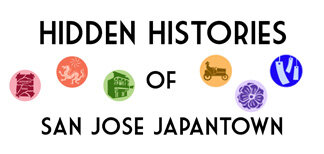Rotating Gallery
JAMsj Rotating Gallery is a space to further explore Japanese History, Art and Culture beyond our permanent gallery exhibits. Admission to the Rotating Gallery is included with normal admissions.
Coming soon
past exhibits
Now in our Rotating Exhibit!
Open in through March 10, 2024, this exhibit will explore the iconic Kimono- as a garment, a cultural symbol, and an expression of activism.
‘The Story Continues’ Exhibition: Celebrating JAMsj’s 35th Anniversary
Curated with memories, personal photos, and excerpts from past exhibits in the Rotating Gallery, "The Story Continues" chronicles 35 years of our history and the dedicated founders and volunteers who envisioned and established the Japanese American Museum of San Jose. Free with admission through January 7, 2024.
Hidden Histories of San Jose Japantown
Learn more about this unique, grassroots project that combines augmented reality technology, art, and local history and culture to explore the little known, and “hidden” stories of connection between the Chinese, Japanese and Filipino communities that together, shaped the Japantown we know today.
Manabu: Oral History Project
Step into the past and help us honor our community's stories of sacrifice, hardship and resilience. We invite you to come and engage with the firsthand experiences of Japanese Americans who experienced the racial tension and hysteria of WWII.
EXQUISITE ART UNDER ADVERSE CONDITIONS
"Exquisite Art Under Adverse Conditions: From The Japanese American Incarceration Camps: 1942-1945," is the extensively remodeled and enhanced section of the museum dedicated to the art and craft created by many artisans who were forcibly held in the camps during World War II.
THE BARRACKS ROOM
The Barracks Room is an accurate recreation of a family’s living quarters at the Tule Lake camp.
SPORTS IN THE JAPANESE AMERICAN COMMUNITY
Sports have always played an integral role in the Japanese American community. Sumo, kendo, judo, Asahi baseball and Zebras basketball were all very popular pre-war sports.
POST WORLD WAR II: RESETTLEMENT
Personal recollections of Japanese Americans returning to the Santa Clara Valley after their release from the camps.
WORLD WAR II: MILITARY INTELLIGENCE SERVICE (MIS)
Second generation Japanese American men and women served in the MIS during World War II and used their language skills in the Pacific theater as translators and POW interrogators.
100TH INFANTRY BATTALION AND 442ND REGIMENTAL COMBAT TEAM (RCT)
The 442nd Regimental Combat Team became the most decorated unit in United States military history. The unit was composed mostly of Hawaiian Japanese Americans as well as volunteers and draftees from the internment camps.
WORLD WAR II: ASSEMBLY CENTERS AND INTERNMENT CAMPS EXHIBIT
During WWII some 120,000 Japanese Americans were forcibly removed and incarcerated. They were placed into temporary "Assembly Centers" then desolate camps in the interior of the United States.
PIONEERS OF SAN JOSE JAPANTOWN
Starting in 1890, Issei (first generation) came to the Santa Clara Valley in search of work. In 1900, Japanese Americans established Japantown, a place for them to meet their social, cultural and economic needs in a society hostile to their presence.
AGRICULTURAL EXHIBIT - YESTERDAY'S FARMER: PLANTING AN AMERICAN DREAM
In the early 1900s, Japanese immigrant families utilized specialized farming techniques to produce high yields of flowers, fruits and vegetables. Learn about these techniques by viewing the farming equipment that they employed.
“This certainly was quite poignant and much more extensive than I had ever realized. A tribute to over 120,000 Japanese American people who were innocent of crime. Just of being Japanese.”














